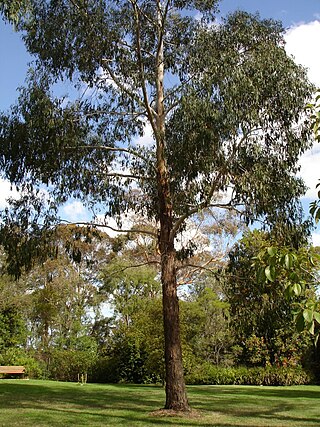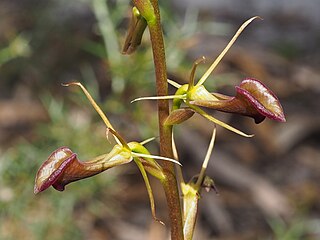
Epacris impressa, also known as common heath, is a species of plant in the heath family Ericaceae. It is native to south-eastern Australia. French botanist Jacques Labillardière collected the species in 1793 and described it in 1805. Four forms have been identified, but no subspecies are recognised. Growing in heathland, shrubland or open forest, it is generally a small shrub around 0.5 to 1 m tall, with small stiff leaves. The red, pink or white tube-like flowers appear from late autumn to early spring. Honeyeater birds, particularly the eastern spinebill, feed upon the nectar of the flowers. It regenerates after bushfire by seed or by resprouting.

Forsythia, is a genus of flowering plants in the olive family Oleaceae. There are about 11 species, mostly native to eastern Asia, but one native to southeastern Europe. Forsythia – also one of the plant's common names – is named after William Forsyth.

Psyllium, or ispaghula, is the common name used for several members of the plant genus Plantago whose seeds are used commercially for the production of mucilage. Psyllium is mainly used as a dietary fiber to relieve symptoms of both constipation and mild diarrhea, and occasionally as a food thickener. Allergy to psyllium is common in workers frequently exposed to the substance.

Carya ovata, the shagbark hickory, is a common hickory in the Eastern United States and southeast Canada. It is a large, deciduous tree, growing well over 100 ft (30 m) tall, and can live more than 350 years. The tallest measured shagbark, located in Savage Gulf, Tennessee, is over 150 ft (46 m) tall. Mature shagbarks are easy to recognize because, as their name implies, they have shaggy bark. This characteristic is, however, only found on mature trees; young specimens have smooth bark.

Nepenthes ovata is a tropical pitcher plant endemic to Sumatra. The specific epithet ovata is Latin for "ovate" and refers to the shape of the lower pitchers.

Neottia ovata, the common twayblade or eggleaf twayblade, is a terrestrial orchid widespread across much of Europe and Asia

Plantago ovata, known by many common names including blond plantain, desert Indianwheat, blond psyllium, and ispaghol, is native to the Mediterranean region and naturalized in central, eastern, and south Asia and North America.

Eucalyptus ovata, commonly known as swamp gum or black gum, is a small to medium-sized tree species that is endemic to south-eastern Australia. It has mostly smooth bark, glossy green, lance-shaped to egg-shaped adult leaves, green flower buds in groups of seven, white flowers and conical to bell-shaped fruit.

Lampsilis is a genus of freshwater mussels, aquatic bivalve mollusks in the family Unionidae, the river mussels. There are over 100 species in the genus.

Schoutenia is a genus of flowering plants. It ranges from Indochina through Malaysia, Indonesia, New Guinea, and Northern Australia.

Goodenia ovata, commonly called the hop goodenia, is a species of flowering plant and is endemic to south-eastern Australia. It is a shrub with sticky, often varnished foliage, toothed egg-shaped to elliptic leaves and racemes or thyrses of yellow flowers.

The Mary River flows in the Northern Territory of Australia and is a site of the Mary River National Park.

Schizomeria ovata, a medium to large Australian rainforest tree, is widespread in warm-temperate rainforest in coastal New South Wales north from Narooma and southern Queensland south from Fraser Island. It is also found in Papua New Guinea and the Solomon Islands.
Thomas Hoy was an English gardener and botanist employed by the Duke of Northumberland at Syon House in Middlesex in the United Kingdom, a position he held for 40 years. Described as "an experienced botanist and able cultivator" he became a fellow of the Linnean Society of London in 1788 and presented a number of flowering plants to the society from which several species were first formally described including the Australian plants Acacia suaveolens, Acacia myrtifolia and Goodenia ovata.

Crassula ovata, commonly known as jade plant, lucky plant, money plant or money tree, is a succulent plant with small pink or white flowers that is native to the KwaZulu-Natal and Eastern Cape provinces of South Africa, and Mozambique; it is common as a houseplant worldwide. Much of its popularity stems from the low levels of care needed; the jade plant requires little water and can survive in most indoor conditions. It is sometimes referred to as the money tree; however, Pachira aquatica also has this nickname.

Caladenia ovata, commonly known as the Kangaroo Island spider orchid is a plant in the orchid family Orchidaceae and is endemic to South Australia. It is a ground orchid with a single hairy leaf and one or two red flowers, sometimes with yellow patches. It is only found on Kangaroo Island and nearby Fleurieu Peninsula.
Pterostylis ovata, commonly known as the Gawler Range rustyhood, is a plant in the orchid family Orchidaceae and is endemic to South Australia. Both flowering and non-flowering plants have a rosette of leaves and flowering plants have up to six flowers which have transparent flanges on the petals and a striped, insect-like labellum.

Cryptostylis ovata, commonly known as slipper orchid or western tongue orchid, is an orchid endemic to Western Australia. It is a common, summer flowering species with dark green leaves with a white central vein and up to fifteen pale greenish flowers with a brownish red labellum with a network of darker veins.
Lechenaultia ovata is a species of flowering plant in the family Goodeniaceae and is endemic to the Northern Territory. It is a perennial herb with rather fleshy, egg-shaped leaves, and white flowers.

Mirbelia ovata is a species of flowering plant in the family Fabaceae and is endemic to the south-west of Western Australia. It is a spreading or prostrate shrub that typically grows to a height of 15–60 cm (5.9–23.6 in) and many branches, covered with woolly or shaggy hairs. Its leaves are egg-shaped, less than 12 mm (0.47 in) long and sharply-pointed. The flowers are arranged in pairs or threes at the base of branches and are yellow or orange and purple and appear from August to October. It was first formally described in 1844 by Carl Meissner in Lehmann's Plantae Preissianae. The specific epithet (ovata) means "wider below the middle".

















